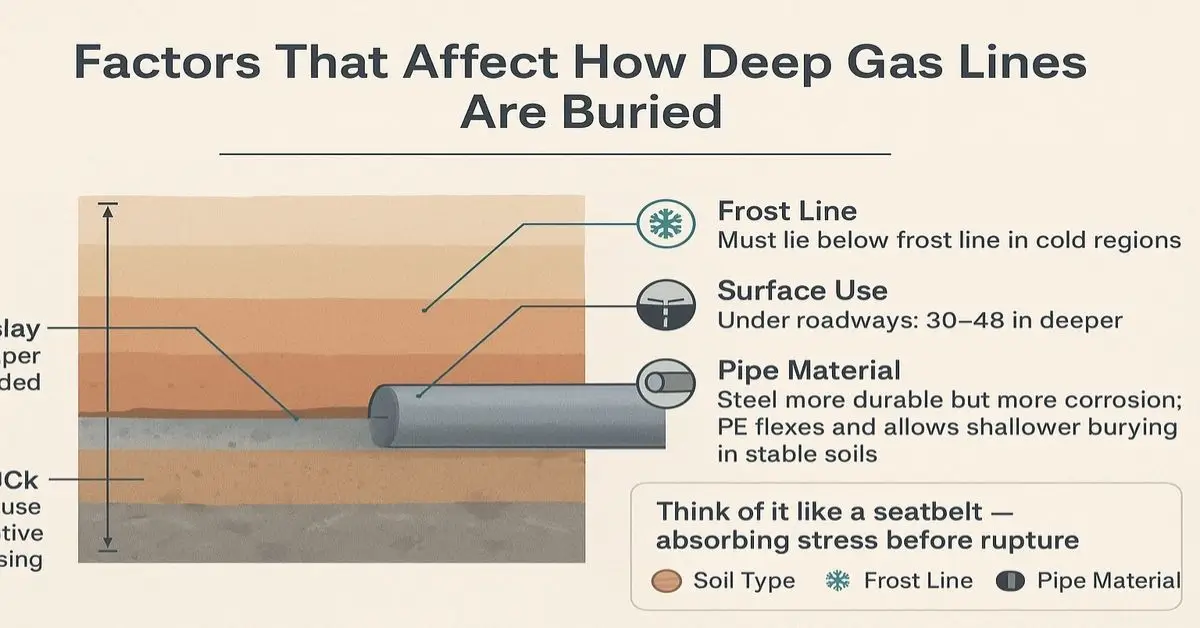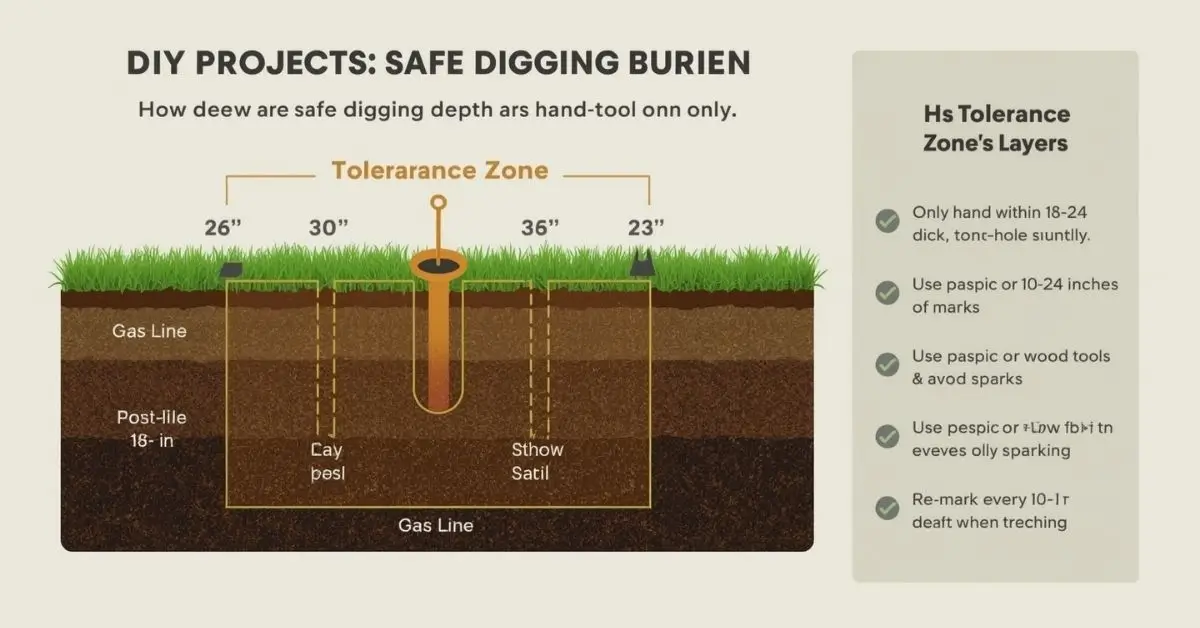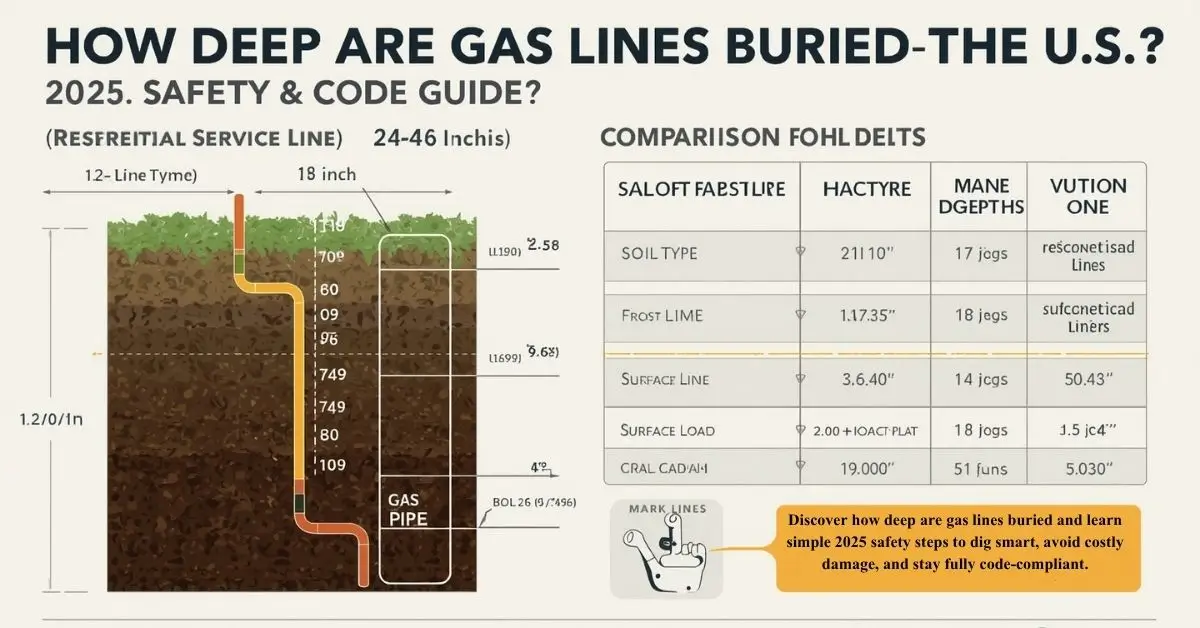Key Intake
Q1: How deep are gas lines buried in residential areas?
Most are 12-18 inches deep, though frost zones or traffic areas may push depth to 24-36 inches.
Q2: Why are gas lines buried underground?
To protect them from weather, tampering, and physical damage while keeping neighborhoods safe and visually clean.
Q3: What’s the minimum safe depth for gas pipes?
The federal minimum is 12 inches for private property and 18 inches for public rights-of-way.
Q4: Which factors affect how deep are gas lines buried?
Soil type, frost line, pipe material, and local building codes determine safe burial depth.
Q5: How do I locate buried gas lines before digging?
Call 811 for free locator services. They’ll mark public lines; private lines need paid locators.
Q6: What’s the difference between main and service line depth?
Main lines (under streets) run 24-36 inches deep; service lines to homes are shallower, 12–18 inches.
Table of Contents
Quick Answer
Most U.S. residential gas lines are buried 12-18 inches deep, and main gas lines run 24-36 inches below ground.
Depth can change based on soil type, frost protection, and local building codes. Always call 811 before digging to locate and mark gas lines accurately. This means what’s safe in California may not be safe in Minnesota, and your property’s gas line could be shallower than you think.
Unlock More Insights
Introduction
Ever wondered what’s hiding beneath your yard? If you’re planning to plant trees, install a fence, or dig trenches, understanding how deep are gas lines buried can save you from disaster. Each year, more than 300,000 underground utility strikes occur in the U.S., and a large share involve shallow or unmarked gas lines (Common Ground Alliance, 2024). That’s not just inconvenient, it’s dangerous.
According to the U.S. Department of Transportation’s PHMSA, most residential gas service lines are buried 12-18 inches deep, while main distribution lines sit at 24 inches or more. But how deep are gas lines buried can vary by state, soil, and frost line.\
Understanding Gas Line Depth Requirements
Gas line depth isn’t a guessing game, it’s regulated for safety and reliability. Federal law sets minimums, but local codes often go deeper to account for regional conditions.
| Type of Line | Typical Depth (inches) | Purpose | Regulating Body |
| Residential Service Line | 12–18 | Connects home to main line | Local Utility / PHMSA |
| Main Distribution Line | 24–36 | Feeds multiple service lines | PHMSA / State Utility Commission |
| Commercial Line | 30–48 | Supports higher pressure & traffic | State / Federal |
| Transmission Pipeline | 36–48+ | Long-distance natural gas transport | Federal Energy Regulatory Commission |
Quick Definition:
Service lines bring gas from the street main to your meter. Mains carry gas under streets to neighborhoods. Transmission lines move gas across regions.
Watch this quick visual breakdown from CountyOffice.org explaining how deep natural gas lines are buried and why proper digging safety matters.
→How Deep Are Natural Gas Lines? – CountyOffice.org
Factors That Affect How Deep Gas Lines Are Buried

Not every property follows the same playbook. Multiple factors determine burial depth, and knowing how deep are gas lines buried helps you estimate safety margins.
1. Soil Type
Clay expands and contracts, so gas lines in clay-heavy areas often go deeper. Sandy or rocky soils require protective casing instead of extra depth.
2. Frost Line
In colder regions, gas lines must sit below the frost line (the depth where the ground freezes). In Minnesota, that’s 36 inches or more; in Texas, it’s often under 18.
3. Surface Use
Areas under driveways or roadways need deeper burial, typically 30–48 inches to prevent pressure or vibration damage.
4. Pipe Material
Steel resists pressure but corrodes faster. Modern polyethylene (PE) gas lines allow slightly shallower installation because they flex with soil shifts.
Think of it like a seatbelt for your home’s energy system: proper depth absorbs stress before a rupture happens.
Regional Variations in Gas Line Depth
Depth standards shift from state to state because of climate, population density, and infrastructure age. If you’ve ever wondered how deep are gas lines buried near you, here’s a snapshot:
| State | Residential Depth | Main Line Depth | Special Notes |
| California | 18 in | 24-30 in | Uniform statewide standard |
| Texas | 12-18 in | 24 in | Follows federal minimum |
| New York | 18-36 in | 24-48 in | Frost protection required |
| Florida | 12-18 in | 24 in | Sandy soil; shallow OK |
| Illinois | 18-30 in | 30-36 in | Frost and traffic load factors |
| Minnesota | 24-36 in | 36+ in | Deep frost zones |
Pro Insight: Regional rules can differ even between counties. Always verify with your local gas utility engineering department, not just customer service.
Why You Should Always Call 811 Before You Dig?

Calling 811 is more than a legal formality, it’s your best protection when learning how deep are gas lines buried on your property.
The national 811 network connects you with local utilities that send locators to mark underground lines within 2-3 business days.
- Free & Mandatory: Every state law requires homeowners and contractors to call 811 before excavation.
- Color Codes: Gas lines = yellow, electric = red, water = blue, telecom = orange, sewer = green.
- Accuracy Tip: 811 marks the horizontal location, not depth. Soil shifting or grading can change burial depth over time.
Real-World Insights (Reddit Comment):
A Nassau County homeowner once shared on Reddit:
“I called National Grid, 811, and even Dig Safe, but nobody could tell me how deep my gas line was. Turns out, it was 18–36 inches deep,so I just grabbed a trowel and checked myself.”
That story sums up the reality: you’ll often need both official data and on-site verification.
What Happens If You Hit a Gas Line While Digging
Hitting a gas line is a serious emergency. Even a minor nick can release gas, risking fire or explosion. The average repair cost for a residential gas strike exceeds $3,500, not including potential fines or injury claims (CGA Damage Report, 2024).
What to do if You Strike a Gas Line?
If you struck a gas line accidentally, while digging then first of all don’t panic and follow the given steps:
- Stop work immediately.
- Evacuate everyone nearby.
- Do not use electronics, vehicles, or phones near the site.
- Call 911 and your gas utility from a safe distance.
Legal Note: Failing to call 811 before digging can make you liable for all damages even if the gas line was shallow or unmarked.
DIY Projects: Safe Digging Depth and Hand-Tool Zones

Homeowners often need 24-36 inches for fence posts, deck footings, or trees. That’s dangerously close to where buried gas lines may lie,making how deep are gas lines buried a critical consideration for any backyard project.
Follow the tolerance zone rule:
- Only hand-dig within 18-24 inches of any marked line.
- Use plastic or wooden tools to reduce spark risk.
- Recheck markings every 10–15 feet if you’re trenching.
Truth is, most people assume all gas lines are at least 3 feet down. They’re not. Many sit just a foot below the grass line, especially older homes built before 1980.
Can You Install or Move a Gas Line Yourself?
No, not legally in most states. Gas line installation and relocation must be done by licensed plumbers or certified gas contractors with proper permits and inspections.
Why Do You Need a Pro?
- Safety: Gas pressure, venting, and testing require trained expertise.
- Code Compliance: Only certified installers can file inspection paperwork.
- Insurance: DIY work may void your homeowner’s policy if a leak occurs.
Pro Tip: Hire installers with PE-certified fusion training if you’re upgrading to polyethylene lines, they’re safer, flexible, and corrosion-resistant.
Myths vs. Facts About Gas Line Depth
| Myth | Fact |
| Gas lines are always 3 feet deep | Most residential lines are only 12–18 inches below ground |
| 811 marks both location and depth | 811 marks location only, not depth |
| All utilities follow the same depth standard | Depths vary by region, utility, and installation year |
| Older homes have deeper lines | Many older homes have shallower lines due to outdated standards |
Modern Installation Depth Trends (2025 Update)
Today’s gas utilities use smart trenching tools, digital locators, and corrosion-resistant pipes to optimize burial depth.
Emerging trends include:
- Smart Mapping: GIS-based depth tracking shared with local building departments.
- Sensor-Enabled Piping: Fiber-optic monitoring of soil movement and pressure.
- Depth Adjustment Codes: Several states (like Colorado and Oregon) now review gas line depths every 5 years to reflect soil and climate data.
These innovations reduce accidental strikes, but they don’t replace homeowner awareness. The safest dig is still the one made after calling 811.
Maintenance and Inspection of Buried Gas Lines

While utility-owned lines are inspected regularly, customer-owned segments (from the meter to your home or grill) are your responsibility.
Inspection Checklist:
- Look for dead vegetation or bubbles in standing water (signs of leaks).
- Have a licensed gas contractor perform annual pressure tests.
- Keep meter areas clear of dirt or mulch buildup.
- Replace steel lines older than 40–50 years with PE piping.
Sources
Below are the top authoritative and reputable references that guided this research on how deep are gas lines buried, each providing verified data, code insights, and safety best practices aligned with U.S. standards:
- U.S. Department of Transportation (PHMSA): Offers regulatory frameworks on gas pipeline cover, excavation safety, and national damage-prevention standards.
- International Code Council (ICC): Provides detailed code interpretations and depth requirements for underground gas piping in both residential and commercial systems.
- Angi Home Services: Summarizes regional U.S. depth ranges, 811 digging procedures, and homeowner safety compliance in accessible language.
- Pipeline Safety Trust: Delivers context on federal safety initiatives, the evolution of natural gas systems, and key causes of excavation-related damage.
- Rex Energy Corporation: Highlights practical safety measures, local variations in burial depth, and modern construction practices across different U.S. states.
Conclusion
When it comes to how deep are gas lines buried, there’s no single number that fits every yard or every state. Depths range from 12 inches to more than 36, shaped by soil, frost, and local code. The real takeaway? Never assume, always confirm.
Before you dig, call 811, check your site plan, and, if needed, get a professional inspection. That simple call could save your property, your wallet, and your life. Because in the world of underground utilities, what you don’t see can hurt you, but what you know keeps you safe.
Author Bio
Evan Cartwright is a Certified Utility Safety Consultant with 12+ years in pipeline safety and residential excavation compliance. Evan helps homeowners and builders understand underground utility regulations and safe-digging practices across the U.S.












